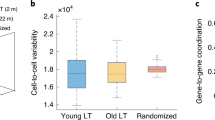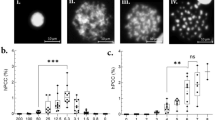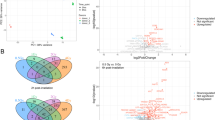Abstract
THE discovery that rearrangements of genes in Drosophila produce ‘position effects’ like the effects of ‘gene mutations’, and that such rearrangements may be so minute as to be practically indistinguishable cytologically or genetically from gene mutations1 has raised the question whether there is any essential distinction between so-called gene rearrangements and gene mutations, or whether the latter are to be regarded merelyas special cases, at the extreme lower limit of size, of the former. This question, fundamental both to problems of genetics and of the biological action of radiation, has recently become more acute since it has become known that, although gross rearrangements vary in frequency as the 3/2 power of the number of ions produced by X-ray irradiation2,3,5 (indicating that they commonly involve the reunion of chromosomes broken at twoor more separated points by separate ionizations or activations), minuterearrangements, like ‘gene mutations’, vary directly as the number of the ions4,5 (indicating that two breaks near together may result from one ionization or activation).
This is a preview of subscription content, access via your institution
Access options
Subscribe to this journal
Receive 51 print issues and online access
$199.00 per year
only $3.90 per issue
Buy this article
- Purchase on SpringerLink
- Instant access to full article PDF
Prices may be subject to local taxes which are calculated during checkout
Similar content being viewed by others
References
Muller, H. J., Prokofyeva, A. A., and Raffel, D., NATURE, 135, 253 (1935).
Muller, H. J., Strahlenther., 55, 72 (1936); Actual, scient, et indust. Reun. internat. d. phys. chem. biol., Paris, 8, 477 (1937); Collecting Net, 13, 181 (1938).
Belgovsky, M. L., Bull. Inst. Gen. (Russ.), No. 11, 93 (1937).
Results of Belgovsky (unpub., ex. lit.).
Muller, H. J., Makki, A. I., and Sidky, A. R., address to Genet. Soc., London, Dec. 1, 1938. Abstr. in press in J. Gen.
Altenburg, E., Amer. Nat., 62, 540 (1928); Anat Rec., 47, 383 (1930); Anat. Rec., 51, 108 (1931); Science, 78, 587 (1933); Amer. Nat., 68, 491 (1934); Biol. Zh. (Russ.), 5, 27 (1936).
Reuss, A. D., Ges. Vererb.; Ber. 11te Jahresvers., 179 (1935).
Geigy, R., Thése No. 895, Univ. Geneva (1931).
Promptoff, A. N., J. Exp. Biol. (Russ.), 7, 552 (1931); J. Genetics, 26, 59 (1932).
Noethling, W., and Stubbe, H., Z. ind. Abst. u. Vererb., 67, 152 (1934).
Stadler, L. J., and Sprague, G. F., Amer. Nat., 70, 69 (1936). Proc. Nat. Acad. Sci., 22, 572 (1936).
Stadler, L. J., Gen., 23, 170 (1938). Stadler, L. J., and Uber, F. M., Gen., 23, 171 (1938).
Brink, R. A., Amer. Nat., 66, 444 (1932).
Stubbe, H., and Noethling, W., Z. ind. Abst. u. Vererb., 72, 378 (1937).
Daniels, Farrington and Heidt, L. J., J. Amer. Chem. Soc., 54, 2381 (1932).
Author information
Authors and Affiliations
Rights and permissions
About this article
Cite this article
Muller, H., Mackenzie, K. Discriminatory Effect of Ultra-Violet Rays on Mutation in Drosophila. Nature 143, 83–84 (1939). https://doi.org/10.1038/143083a0
Published:
Issue date:
DOI: https://doi.org/10.1038/143083a0
This article is cited by
-
Cytogenetic analysis of the action of carcinogens and tumour inhibitors inDrosophila melanogaster iv. The cell stage during spermatogenesis and the induction of intra and inter-genic mutations by 2:4:6-tri(ethyleneimino)-1: 3:5-triazine
Journal of Genetics (1955)
-
The lack of proportionality between mutation rate and ultraviolet dose in Drosophila
Heredity (1954)
-
The mechanism of the induction by radiation of chromosome aberrations inTradescantia
Journal of Genetics (1942)
-
Mutationsauslösung durch Ultraviolettes Licht bei Drosophila
Zeitschrift für Induktive Abstammungs- und Vererbungslehre (1942)
-
Spontaneous chromosome change
Journal of Genetics (1941)



